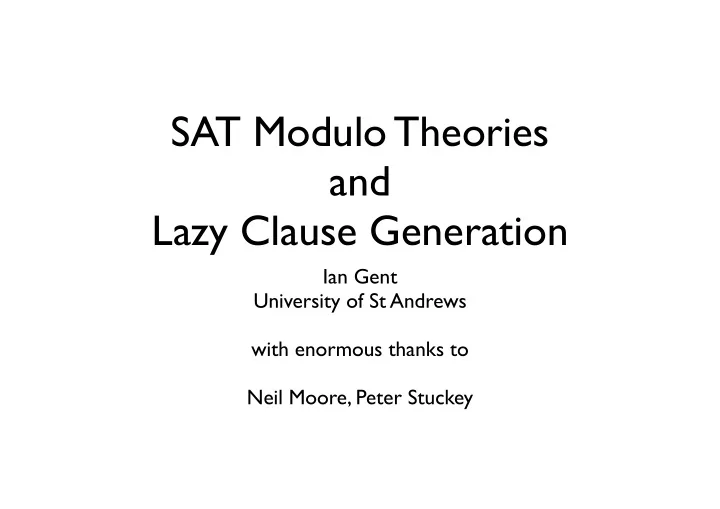

SAT Modulo Theories and Lazy Clause Generation Ian Gent University of St Andrews with enormous thanks to Neil Moore, Peter Stuckey
Topics in this Series • Why SAT & Constraints? • SAT basics • Constraints basics • Encodings between SAT and Constraints • Watched Literals in SAT and Constraints • Learning in SAT and Constraints • Lazy Clause Generation + SAT Modulo Theories
SMT & LCG • SAT Modulo Theories • Lazy Clause Generation • Two areas where constraints/SAT most tightly integrated
SAT Modulo Theories • Extremely important & trendy area • Will dismiss it in a few slides • because ... • Integration with Constraints not so tight ... and • Nieuwenhuis & Stuckey agree they are converging together ... and • I am running out of time ... and • I know very little about it ... and • I like “Lazy Talk Generation”
SMT • Idea is simple • SAT is very good at search on literals • We may have theory reasoners good at their thing • Combine the two • Search using SAT • Reason using theory reasoner
SMT example • Simple example based on software checking • solution means type error x > 0 • SAT literals are ∧ y > 0 • x>0 • ∧ ( x > y → y − x ≤ 0) y>0 • x>y ∧ ( x ≤ y → 42 ≤ 0) • y-x ≤ 0 • Moore PhD, based on Gordon 2009 42 ≤ 0 [= false]
SMT example • Simple example based on software checking • solution means type error x > 0 • SAT literals are ∧ y > 0 • searched on as if simple literals ∧ ( x > y → y − x ≤ 0) • i.e. SAT solvers knows ∧ ( x ≤ y → 42 ≤ 0) nothing about inequalities • solution found by assigning Moore PhD, based on Gordon 2009 literals true / false
SMT example • SAT might search to get... • x>0 T x > 0 • y>0 T ∧ y > 0 • x>y F ∧ ( x > y → y − x ≤ 0) • y-x ≤ 0 T ∧ ( x ≤ y → 42 ≤ 0) • 42 ≤ 0 T Moore PhD, based on Gordon 2009
SMT example • SAT literals are • searched on as if simple literals • i.e. SAT solvers knows nothing about x > 0 inequalities • solution found by assigning literals ∧ y > 0 true / false • SAT solution given to theory reasoner ∧ ( x > y → y − x ≤ 0) • which either • accepts it ∧ ( x ≤ y → 42 ≤ 0) • or fails and gives explanation • Explanations are clauses and treated as in Moore PhD, based on Gordon 2009 SAT solving
SMT example • SAT might search to get... x > 0 • ... ∧ y > 0 • x>y F • 42 ≤ 0 T ∧ ( x > y → y − x ≤ 0) • Fail! ∧ ( x ≤ y → 42 ≤ 0) • Learnt clause might be Moore PhD, based on Gordon 2009 • x>y
SMT example • SAT literals are • x>0 T x > 0 • y>0 T • x>y T ∧ y > 0 • y-x ≤ 0 T ∧ ( x > y → y − x ≤ 0) • 42 ≤ 0 F • Theory reasoner succeeds! ∧ ( x ≤ y → 42 ≤ 0) • sets e.g. x=9, y=10 Moore PhD, based on Gordon 2009 • so software bugged
SMT Solving • Search in SAT • Theory Decisions • Theory Propagation • not seen in toy example • tell theory about every decision • let it propagate (if it can) • and communicate results by explanation • Learning and Theory Explanations
SMT vs Constraints • SMT has broader reach than constraints • Can use any theory we like • If we can code it as a theory • Many theories encoded into SMT • Theories need not even be decidable • so more general than Constraints • SMT has less coverage in constraints • Constraint type theories not well developed • E.g. Alldiff theory only recently produced (2010??) • Not clear that propagation as effective
Lazy Clause Generation • Alternative track of research • starting with • Ohrimenko, Stuckey, and Codish, 2007 • But as optimisations made on both sides • SMT and LCG converging • So SMT more general • But LCG much better at constraint problems
Lazy Talk Generation • Dear Peter ... “I wonder if there's a lazy solution for me, to steal some of your slides on lazy clause generation? This would save me lots of time and also let me present it accurately instead of wrongly! It won't go without saying I'd give you full credit for the slides.” • Slides available from http://ww2.cs.mu.oz.au/~pjs/637/lec/
Recommend
More recommend